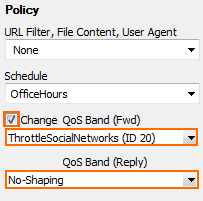Configuring an application rule is similar to configuring an access rule. You can enable Application Control features on a per-access-rule basis. Application rules allow you to block or throttle traffic for detected applications. You can optionally combine the application rule with URL filter policy objects. The application ruleset is evaluated every time an access rule matches that has enabled any of the Application Control options. Make sure the matching access rule allows all protocols needed for the applications you are creating policies for. The application ruleset can be created as a positive or negative list, depending on whether the default policy is set to allow or block undetected applications per default. In most cases, setting the default policy to allow undetected applications and then creating application rules to block or throttle application traffic is the recommended setup.
Before You Begin
- Verify that you have enabled Application Control and that you are using the latest feature level of the Firewall service. For more information, see How to Enable Application Control.
Create Application Objects and/or Application Filters necessary for your application policies. For more information, see How to Create an Application Object and How to Create an Application Filter.
Step 1. Enable Application Control Features in the Access Rule
- Go to CONFIGURATION > Configuration Tree > Box > Assigned Services > Firewall > Forwarding Rules.
- Double-click to edit the access rule you want to enable application control for.
Click on the Application Policy link.

Select the Application Control features to be used for this access rule:
Application Control
SSL Inspection
URL Filter
Virus Scan
ATP
File Content Scan
Mail DNSBL Check
Link Protection
Safe Search
YouTube for Schools
Google Accounts
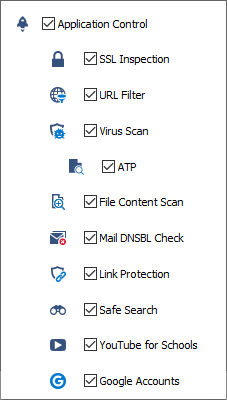
- Click OK.
- Click Send Changes and Activate.
Step 2. Create an Application Rule
For each application policy create an application rule. Rules are evaluated from the top to bottom. The action set in the first matching rule that is executed.
- Go to CONFIGURATION > Configuration Tree > Box > Assigned Services > Firewall > Forwarding Rules.
- In the left menu, click Application Rules .
- Click Lock.
(optional) Customize the application ruleset – To allow or deny all application traffic if none of the rules matches.
Click Application Rules on top of the rule list.

- Select one of the following options from the drop-down list:
- Allow on No match (default) – Application traffic is allowed if none of the application rules matches.
Block on No match – Application traffic is blocked if none of the application rules matches.
- Click the green plus sign (+) in the top right of the page, or right-click the ruleset and select New > Rule. An application rule New Rule is added to the application ruleset.

- Double-click on the New Rule application rule you just created. The Edit Rule window opens.
- Select Pass or Deny as the action.
- Enter a name for the rule. For example,
LAN-DMZ. - Specify the following settings that must be matched by the traffic to be handled by the access rule:
- Source – The source addresses of the traffic. The source must be the same or a subset of the source of the matching access rule.
- Destination – The destination addresses of the traffic.The destination must be the same or a subset of the destination of the matching access rule.
- Application – Select the application object or application filter.
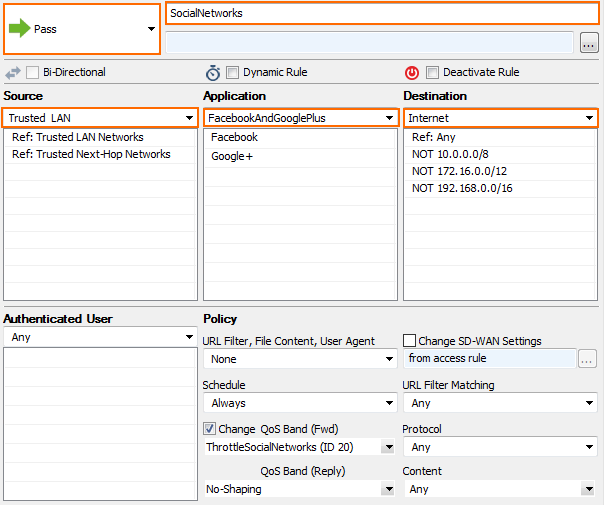
- Set Additional Matching Criteria or change the QoS Bands as needed (see below).
- Click OK.
- Drag and drop the application rule so that it is the first rule that matches the traffic that you want it to forward. Ensure that the rule is located above the BLOCKALL rule; rules located below the BLOCKALL rule are never executed.
- Click Send Changes and Activate.
Additional Matching Criteria
- Authenticated User – Select a user object to apply this application policy only to a specific user group. For example, you can use this to allow social media access to specific employees, whereas an application policy below denies it for everybody else. For more information, see User Objects.
- Schedule Objects – Applies time restrictions to the application policy. For example, you can use a schedule object to throttle social media during office hours. For more information, see Schedule Objects.
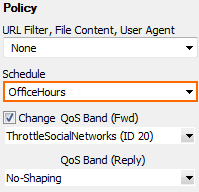
- Protocol – Selecting a protocol object for a detected application allows to apply a policy that will deny an application the usage of this protocol, or alternatively apply a higher traffic shaping queue to the VOIP feature of an application. Protocols not allowed by the matching access rule cannot be allowed in the application rule. For more information, see How to Create a Protocol Object.
- Content – To block specific file types, such as PDF, EXE or content category such as Audio or Video, select the Content ID from the list.
URL Filter
You can combine URL filtering with application control. Use URL filter policy objects or URL Filter Match objects to block website categories.
- URL Filter Policy – URL Filter policies define the allow/block/warn/alert policy for every URL filter category. To apply that policy to the application rule, select the URL filter policy object from the list. For more information, see How to Create an URL Filter Policy Object.
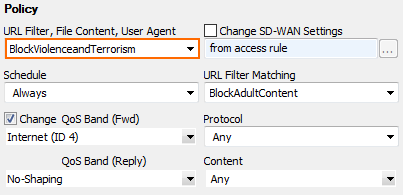
- URL Filter Matching – URL Filter matching is used to assign additional policies such as traffic shaping or SD-WAN settings to web categories. For more information, see How to Create a URL Filter Match Object.
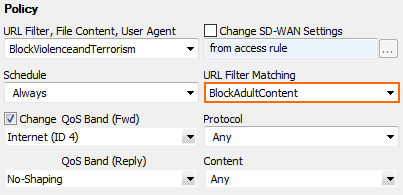
Applying Traffic Shaping to Detected Applications
Applications cannot only be allowed or denied, you can also change the QoS band assigned to the traffic matching this application rule. This allows you to throttle or prioritize applications as needed. By default, the QoS band of the matching access rule is used. For more information, see Traffic Shaping.
- Change the QoS Band – Select this check box to use a different QoS band than the QoS band used by the matching access rule.
- QoS Band (Fwd) – Select the QoS band to be applied to the outgoing application traffic matching this application rule.
- QoS Band (Reply) – Select the QoS band to be applied to the incoming application traffic matching this application rule.
